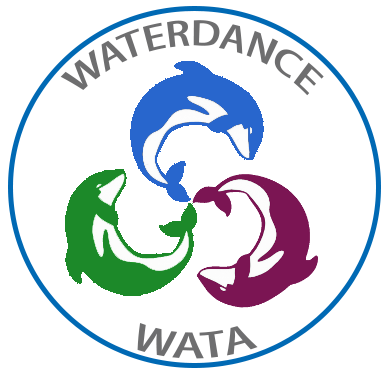WATA Fundamental Class – 50 hours
Prerequisite: none
This 50 hours class is both a water and land-based path to prepare those new to the water as well as for those who already have Aquatic Bodywork experience (Watsu, Jahara and others…). The Fundamentals of WaterDance are presented in a way that students have time to explore and embody what they are learning. It encourages participants to be with the body, the mind, the emotions and the breath (of oneself and the other), fully awake and aware to all that stems from the stillness within. Students are invited to engender trust and to establish the necessary breath connection for submerging.
With these fundamentals, students will be ready to continue on and eager to learn the moves of WaterDance I. WaterDance Fundamentals serve as prerequisite for WaterDance I. But it can also be attended like a spiritual growth and self–discovery workshop.
WATA I (WaterDance I) – at least 50 hours
Prerequisite: WaterDance Fundamentals, Basic Seminar (IAKA), WATSU® I, Healing Dance, Jahara or Instructor Approval (one on one teaching)
In water
In WaterDance I, you will explore the art of breath connection enabling you to establish a deep rapport with your clients, inspire their trust and offer the attentiveness that is necessary when bringing someone below the water’s surface. From this place, you will learn the “WaterDance short form” which includes learning to establish a rhythm that works with each client’s breathing needs and to move all body types through the water with security, ease and graceful fluidity, giving the receiver a profound sense of freedom and joy.
On land
Whether we spend time on land, in a carefully prepared practice room, or in an outdoor setting, it is essential to be able to enjoy a space for growth and authentic encounter with each other, in our “natural” element: the Earth. To counteract the Water element, we propose a wide range of exercises, respecting also the 3 other elements (Air, Earth and Fire – see below).
WATA II (WaterDance II) – at least 50 hours
Prerequisite: WaterDance I
In water
In this course, you will build on and deepen the work of WaterDance I, taking the same principles and material and expanding on them with a fuller repertoire of underwater moves and techniques, the “WaterDance expanded form”. You will as well learn how to link different moves so your technique will become more fluid and flowing – like a real dance in water. By the end of this course, you will have learned enough material to give full WaterDance sessions that are fun, healing and profound.
On land (see under WATA I and below)
WATA III (WaterDance III) – at least 50 hours
With WaterDance, there will come the moment when the practitioner is ready to leave technique to step into a new dimension, in which the creative aspect is invited to unfold in its beauty and full potential. In WaterDance III, we invite you on a journey, which will lead you to more creativity and spontaneity. In Free Flow, you expand on the WaterDance I and II foundations taking your repertoire of technique into the realm of true dance. You will be guided to create your own underwater moves. We focus on the present moment with all our senses. With this kind of presence, your dance will be directly connected with your partner; it becomes creative, spontaneous, playful and perhaps different from all that we have done so far with WaterDance.
On land (see under WATA I and below)
Exercises, respecting the 3 other elements:
For the Air
We explore the deep meaning of breath with many different breathing exercises. Having an intimate relationship with our own breath is the fundamental basis for being in harmony with the recipient’s breath. Bringing another person underwater requires an open presence and a very fine listening capacity of the said and the unsaid.
For the Earth
We practice simple exercises, in the classroom or in nature, helping us to connect with our center and our roots, which is essential for good stability and grounding in water.
For the Fire
We approach the spiritual aspect of our work by different meditation techniques: by meditating in silence or accompanied by the movement, or simply by being in the present moment with each of the proposed activities.
